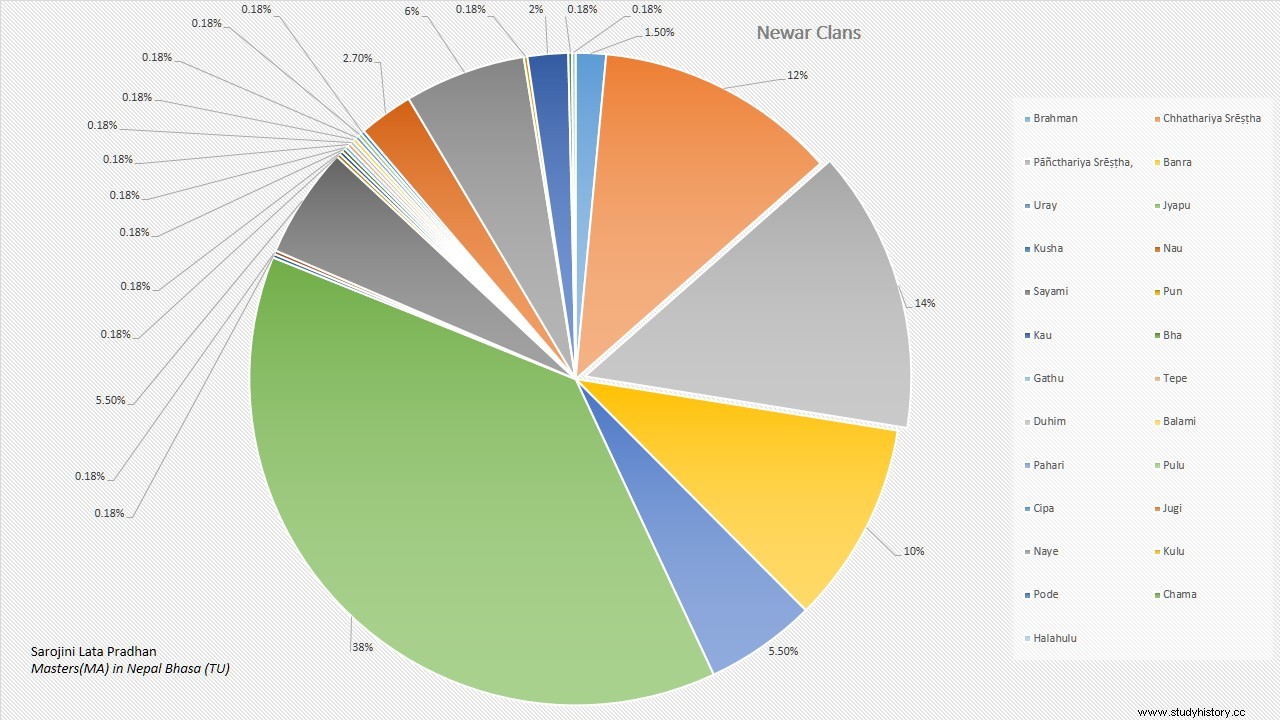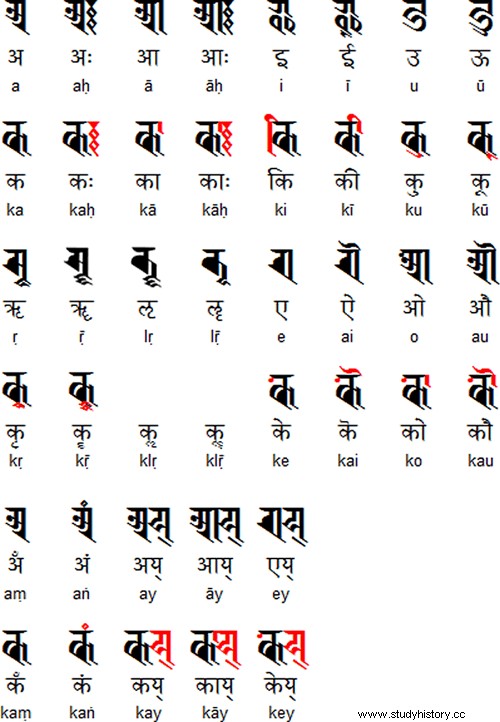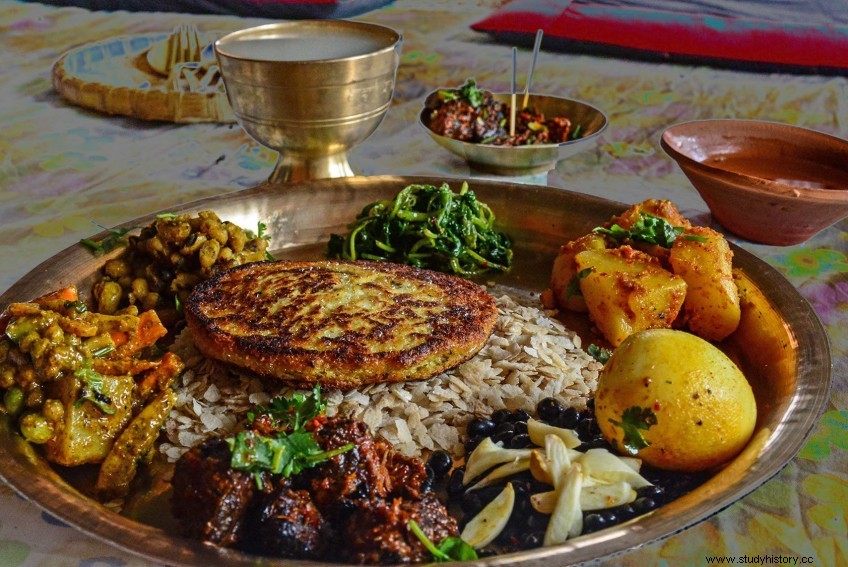Nepal is a small country between India and China with a population of around 28 million people. In this dense country, there are many traditions and cultures that mix with each other. One of the caste systems with a rich history covering 5% of the Nepalese population is the Newar people.
The Newar people were the first group to live in the Kathmandu Valley that inspired Prithivi Narayan Saah to unite the country while standing on top of Chandragiri Hill. The culture and history of the Newar people is an important part of Nepal and worth discussing.

History
Before Nepal became the unified country it is today, they were small tribes of people who met only to trade goods. The king at that time was King Jayasthiti Malla. Using other higher caste Newars, called Bramis, he segregated the group into four major Newar groups. These groups were Brahmin, Kshatriya, Vaisya and Shudra. The inhabitants were then placed in each category depending on the profession, with Brahmins as nobles or the ruling class.
Kshatriya were working class people with education. Vaishya were also working class people, but were less educated, if at all. The lowest caste is the Shudras, who have no access to education and do the work that no one else will. After the country was united, the other groups were also assimilated into one of these categories. It did not change the hierarchy of the various Newars that were in place as before.
The Newar-caste people all had different surnames, which helps them identify with each other with what kind of Newar they are. Each caste has a number of different surnames, and with the mix of new Nepalese people in the Kathmandu Valley, there are people who are not Newar, but have one of Newar's surnames, such as Malla, Sharma and more.

The clash between religion and caste
The most common religion in Nepal is Hinduism, and is 81% in the country. The second largest religion is Buddhism, which sits at 8%. Newars had people in both religions, and when the caste system came into being, these two groups also differed.
"While the Rajopadhyaya Brahmins (or Déva-bhāju) occupied the highest social position on the Hindu side, Vajracharya (or Guru / Gu-bhāju) formed the head among the Buddhists." (Wikipedia)
The Hindu newcomers place greater emphasis on the nobles and royal blood, while the Buddhists placed the monks and priests on a higher shelf. Many of the Tibetan migrants also joined the Buddhist Newar as they grew in relation to each other by trade.
Who are the cast members called shudra?
Shudra, also called Dalit, is the lowest caste in the Newar caste system. They are the uneducated and so-called uncivilized group of people. They spend their days working as other people refuse to do, and barely make money from the hard work. All the other cast members look down on them and go so far as to refuse to touch them or anything they have touched. People do not even give the time of day. Even today, with many Shudras working in better jobs, there is still a lot of segregation and discrimination against these people.
Being at the bottom of the barrel has continually kept them from achieving greater wealth to this day. Many Shudra people do not have the money to go to school. This allows them to beg for money and food on the streets. Due to a lack of education, they also do not have an accurate representation in higher paying jobs or a fair voice in the courts. The Shudra people make up about 13% of the Nepalese population, and yet they still do not get the same rights as other citizens.
Newar clothes
Just as every cultural group has its own kitchen and clothes, Newars does not disappoint. South Asian clothing usually consists of saris. They are a long cloth that the person wraps around them and then becomes a curtain on the shoulder. This is a bit of the same style for Newar clothing.
Woman Clothing

A typical Newarni in his old age would wear this on a daily basis. As times have changed, only a few use them. Now women wear this traditional outfit on special occasions like New Year and other special holidays. This outfit is Haku patasi. The black cloth with the red edge is usually a six foot long cloth that is wrapped around the lower half of the woman's body. The top blouse is always a cotton blouse with a similar pattern as the one in the picture and long sleeves. The outer white cloth is slightly shorter than the black cloth, but it is also wrapped around the woman's body which she then throws over her shoulder.
The jewelry consists of lots of gold from top to toe. Gold bracelets, golden ankles, a red necklace with pearls and a red hairpin are always present. But there are other pieces of jewelry that Newar women do not always wear. However, they do not wear the golden headdress in everyday life, as it can be quite heavy.
Men's Clothing

While women's outfits are different in every caste in Nepal, men remain the same. It consists of a hat (dhaka topi), a suit vest and a pajama set (daura suruwal). The colors may vary, but most traditionally gray is the most popular color that men use. For wedding ceremonies, however, the design changes slightly. On the wedding day, the groom wears a datura suruwal that matches in the style of what the bride is wearing. He will also carry a knife called a kukuri on the side, which symbolizes his promise to protect his new bride and show his strength.
Newari goddess

The living goddess Kumari is a popular place that hundreds of Nepalese citizens visit every year. A Kumari is a girl born into a pure Newar family who must not have impurities and must live as a living goddess until the day she reaches femininity. Womanhood is symbolized by the fact that she had her first period. The belief is that when the current Kumari gets her period, Teju, the god, leaves the woman and enters the body of a new child. Sometimes a Newarni is picked from her family and thoroughly tested to see if she is the next living goddess. It is usually more than one girl who is picked out. Through thorough inspections and testing, they choose the one that best matches the description of a Kumari. The tests are as follows:
They found Nepal's Royal Kumari a healthy baby girl, with no cuts or scars on the skin, intact teeth will fit best. Once selected, the kumari must pass a test of 32-body perfection. A ritual is known as "Battis Lakshan".
Criteria for 32 body productions - some samples
- She should have a banyan-like body
- Her eyelashes would be like those of a cow
- She should have a conch neck
- Her voice must be as sweet as a duck
- She must have a coffin like a lion
- She must not bleed, etc.
(Mukherji)
Once a girl is picked out, she must live inside a special palace where she is not allowed to meet her family. She is not allowed to go without the help of the caregiver. If she were to smile or laugh, it is a symbol of impending doom or even the death of the person she is smiling at. If she chooses her food, it is a sign of great financial loss. There are many other beliefs that come with this goddess, but these are the main actions that people take care of.
From head to toe she is the embodiment of purity and goodness. People from all over Nepal stand outside her palace to catch a glimpse of her. If people are able to go in and visit her in person, they will bow their heads and touch her feet to bless. Even the Prime Minister and President of Nepal visit her to seek her blessings.
Life after Kumari
When the young Kumari has her first period, it represents that God is leaving her body. God moves on to his next vessel. The current ex-Kumari is then removed from the palace walls and left to himself. People who once looked up to the girl as a goddess now release her and refuse to touch her, as she is no longer the pure being she once was.
Many of these girls have never done anything for themselves and have no idea what the basics are. This makes it difficult for them to live a normal life outside the palace walls. Some are alone and have no family to return to. This leads them to a negative place. They end up having to live the rest of their lives on the streets. Those who have families to return to, do so and try to live as normally as possible again.
Today, Kumaris who return to a normal life are given the opportunity to have an education that they were not able to have before. Many go to public schools and live a normal life, and a few go to school through private teachers.
Newar language

The main language of Nepal is Nepali. This may be the main language, but many Newarians do not speak it. They speak another language called Newari or Newar bhasa. The Newari language also follows the Sanskrit alphabet. Over time, it has undergone changes other than the official Nepali language. Many Newar people who still live in the villages continue to speak their mother tongue and teach their children. However, it is not so widely used in the Kathmandu Valley. The language is slowly dying out, as many children in the village do not find use for the language. Yet more than a million Newar people continue to use the language.
Since the capture of the Kathmandu Valley by the Rana Empire, the Newar government in the Kathmandu Valley has been severely suppressed. Although attempts have been made to eradicate the language, the language continues to persist. It continues to remain strong in the hearts of the Newar people. The language also lives on in texts from the past, in manuscripts and poems and other forms of literature.
Newar Cusine
South Asia is known for all the spices they use in their dishes. Newar food consists of a large portion of rice and all kinds of delicious side dishes around it. The dishes consist of meat, either eggs, chicken or goat. Sometimes even both. Then we have the vegetables, which are usually potatoes and beans. On the side there are also pickled vegetables such as pickled chili or mango. These pickled vegetables are spicy and the perfect kick to any meal. This does not even include the green chili that they mash between the main course. In a separate bowl, they have lentil soup made from shared chickpeas. It can also be mung beans. They mix the vegetables with the rice and spread the lentil soup on top of it all.
Sometimes the Newar people eat the meal with rice, and other times they eat it with roti. There is also a snack version of this meal, and some of the items are different. Rice turns into chiura. There is no more dal, but instead soup from the meat, and there are always cool vegetables like carrots and cucumbers. It is a delicious meal that people even outside the Newar community like to eat. It's especially fun to eat it with your hands instead of a spoon, as you can taste flavors and spices even better.

Conclusion:Newar's cultural significance in anthropology
Nepal is a collection of people with different backgrounds and cultures. Before the unification of Nepal, the main group of people living there were Newars. As the years have passed, many people from many different castes live there now, but the history of the Newar people remains. From the culture to the language to the food, the Newar people have been able to adapt and continue their rich history so that others can also enjoy it. Some parts of their culture are just for them, but the story is far from over. One can learn a lot about the country through its strong ties to Nepal's history. The culture of the Newar people is worth learning from an anthropological perspective, as it is an important culture that continues to define large parts of Asia.
